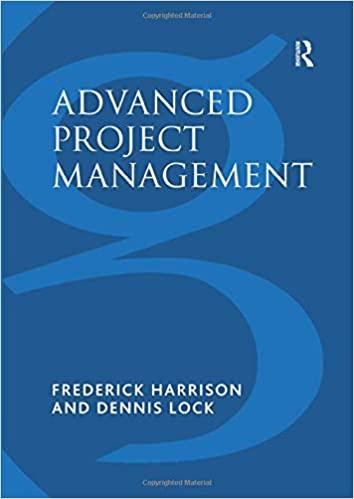Question
Nikki started by talking with her parents about some of the estimated sales and costs that they thought would incur for the month of September.
Nikki started by talking with her parents about some of the estimated sales and costs that they thought would incur for the month of September. Here are some of those estimates: Total Apple Pies Caramel Apples Sales price (per unit) $30.00 $9.50 Expected sales units (for September) 18,000 8,500 9,500 Expected Manufacturing costs: Total Apple Pies Caramel Apples Fixed OH (per month) $24,875.00 $19,500.00 $5,375.00 Direct labor (per unit) $4.00 $2.40 Direct materials (per unit) $3.25 $1.80 Variable OH (per unit) $2.50 $1.20 Expected Marketing and admin costs: Fixed costs (per month) $7,625.00 $6,000.00 $1,625.00 Variable costs (per unit) $1.45 $0.35 Additionally, Sally informed her that the farm received a special order to sell their apple pies and caramel apples at the local county fair in September. Sally wanted to sell 3,500 pies and 4,500 caramel apples for a discounted price of $20.00 and $7.50, respectively. With, the number of staff and the size of the bakery, Nikki determined that the maximum capacity for the bakery is 4,200 labor hours a month. At the current projected sale amounts she expects that theyll need 3,550 hours to meet their regular sales volume. After review of the salaries of all the staff, Nikki determined that the average hourly wage was $16.00. Ned was also concerned about how much it cost to keep apple pie inventory on hand at the end of the month, caramel apples should be sold within a couple days, so no inventory is left at the end of the month. Since there is a limited shelf life for the apple pies, Ned and Sally try and keep the ending inventories in line with next months expectations. They estimated that theyd have to start 10,000 apple pies in order to have 1,000 apple pies in-process at the end of the month and 500 finished pies. At the end of August there were 500 pies that were in-process and no finished pies.
The variable costs associated with these inventories were as follows: DM Conversion Beginning WIP inventory $2,575 $4,225 September costs $32,500 $40,000 And the conversion cost for the in-process pies is 50% completed and 100% for direct materials. (Use the paragraph above to calculate the units completed and transferred out for work-in-process pies) September was a success for the bakery! They didnt complete the special order but focused on normal sales and with some overtime baked a few more pies. Here were the results for the actual sales and costs at the end of the month. (The actuals as presented below are only to be used for Problem 6.) Total Apple Pies Caramel Apples Actual Sales price (per unit) $32.00 $10.00 Actual sales units 19,500 9,000 10,500 Actual variable manufacturing OH $133.225 Actual variable marketing and admin cost $19,200 Actual fixed manufacturing costs $22,150 Actual marketing and admin costs $8,750
Problems 1. For Apple Pies only, compute the variable manufacturing costs per unit, full unit cost per unit, variable cost per unit, full absorption cost per unit, prime cost per unit, conversion cost per unit, profit margin per unit, contribution margin per unit, and gross margin per unit. 2. Calculate the total profit expected for September, compute the weighted average contribution margin, and compute the breakeven in units. 3. Calculate the labor hours needed for the special order, calculate the incremental profit/(loss) for the special order, calculate the capacity available for regular orders, compute the contribution margin per hour for regular orders, compute the contribution margin lost from regular sales orders, calculate the total contribution margin including the special order. 4. Prepare the journal entries as given on the excel workbook. 5. Using the Weighted-Average method create the Production Cost Report for Apple Pies only, to include computing the total Apple Pies to be accounted for, computing the total Apple Pie costs to be accounted for, and calculating any necessary adjustments. 6. Create a Budget Analysis Report for the month of September, to include creating a Master Budget, and calculating the variance analyses between Actuals versus the Flexible Budget and versus the Master Budget. Note those variances as either being Favorable (F) or Unfavorable (U). Problem Analysis 1. What costs are excluded from the Gross Margin calculation? Why would we exclude these costs? 2. What does the mix of the weighted-average contribution margin tell us about the impact to profits of each product? 3. Should Apple Hilly Farms complete the Special Order? Explain your answer by using pricing terms from the textbook. 4. Was manufacturing overhead under or over applied? What does over or under applied overhead mean? 5. Why would Apple Hilly Farms use standard costing since actual costing gives the actual cost? Why would they not want to wait until the actual costs are known? 6. Explain the variances calculated for Apple Hilly Farms. Why was September a good or
Step by Step Solution
There are 3 Steps involved in it
Step: 1

Get Instant Access to Expert-Tailored Solutions
See step-by-step solutions with expert insights and AI powered tools for academic success
Step: 2

Step: 3

Ace Your Homework with AI
Get the answers you need in no time with our AI-driven, step-by-step assistance
Get Started


